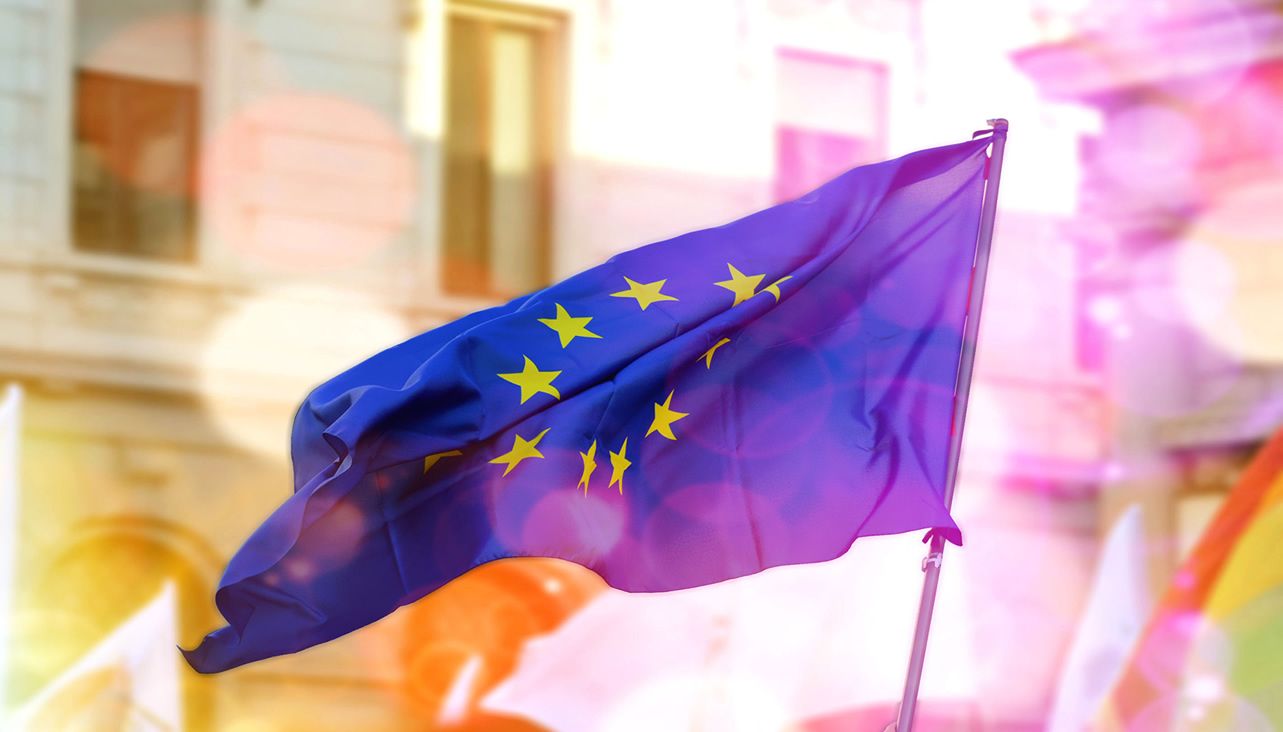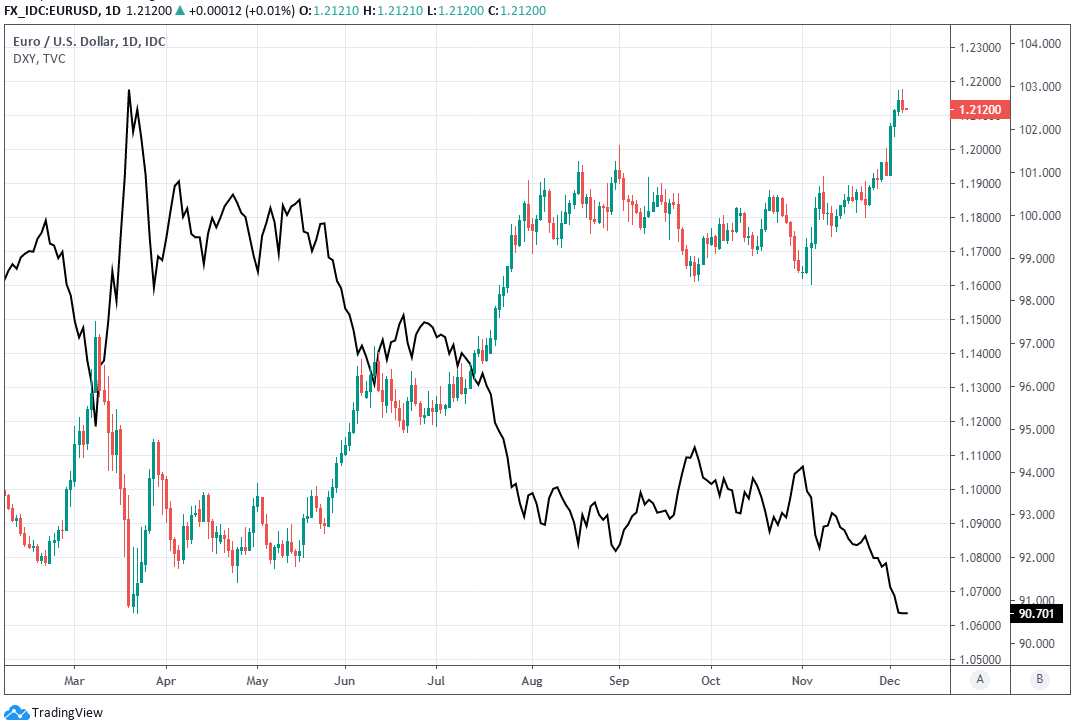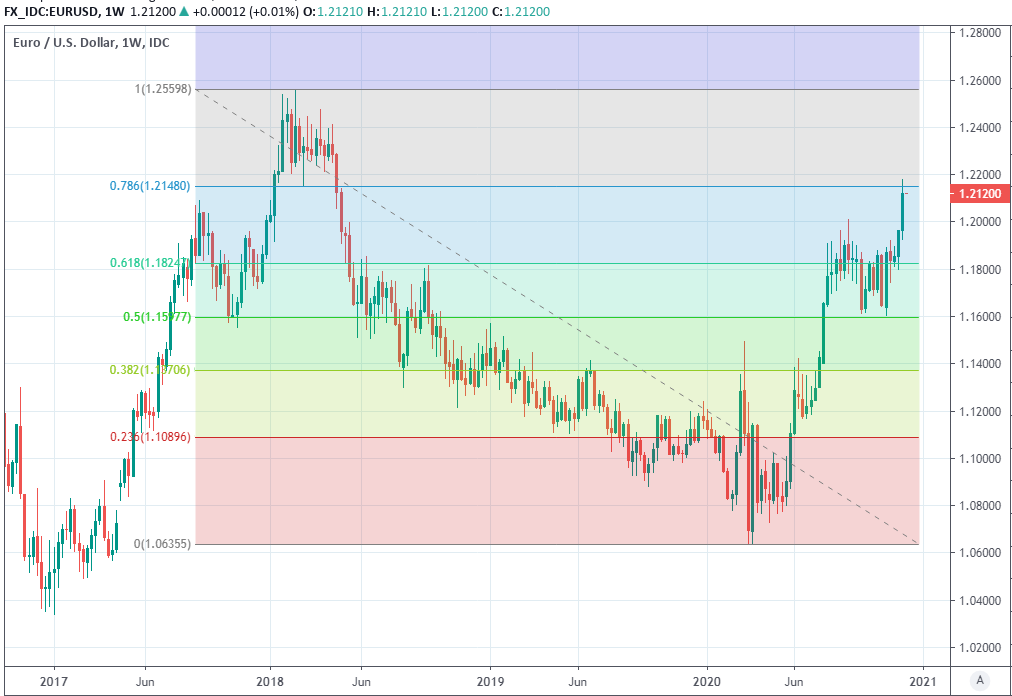Euro-Dollar Week Ahead Forecast: Political Panfires, Chart Resistance Risk Canceling Christmas
- Written by: James Skinner
-
- EUR opens facing immediate resistance, cocktail of political risk.
- UK's possible 'no deal' gambit risks EUR declines from 2018 high.
- EU budget row could complicate EU's 'no deal' firefighting effort.
- EU summit, budget row & ECB decision add to EUR headwinds.

Image © Adobe Images
- EUR/USD spot rate at time of writing: 1.2149
- Bank transfer rate (indicative guide): 1.1719-1.1804
- FX specialist providers (indicative guide): 1.1962-1.2059
- More information on FX specialist rates here
The Euro-to-Dollar rate achieved a new milestone last week when reaching its highest level since early 2018 but overhead resistance on the charts and series of political panfires risk cancelling or otherwise curtailing the single currency's Christmas celebrations in the week ahead.
Europe's single currency rose to its highest since April 2018 last week after Britain's approval of the Pfizer and BioNTech coronavirus vaccine stoked further cheer among investors for having enhanced the outlook for a 2021 global economic recovery.
But political panfires including an EU row with Poland and Hungary as well as a seemingly growing threat of a 'no deal' Brexit risk polluting the otherwise bullish atmosphere ahead of Thursday's European Central Bank (ECB) decision, which may see it again attempt to coax the Euro down from near three-year highs.
"Risks for the USD are skewed to the upside as short positioning is looking stretched and the USD increasingly trades at a discount to its shorter-term drivers. Simply put, we think the EUR's rally has gotten too far ahead of its underlying fundamentals," says Ned Rumpeltin, European head of FX strategy at TD Securities. "As a result, we are now fading the move and entering a short at 1.2165, targeting a move down to 1.18 with a one-month expected horizon."
Customary in financial markets is the often self-fulfilling prophecy of a so-called Santa Rally that lifts stock markets and positively correlated currencies like the Euro through December and into the New Year, but if Christmas didn't come early in November, then it might be at risk of not coming at all in 2020.
Christmas or the Santa Rally at least could be cancelled if TD Securities is right in expecting a Euro-Dollar decline to 1.18 by year-end.
Whether it does or not depends in part on whether British and EU negotiators are able to strike a deal in their final moments of talks on Monday, because without one Prime Minister Boris Johnson could announce that evening that a December 31 'no deal' exit from the transition has become Britain's course of action.
Above: Euro-to-Dollar rate shown at daily intervals alongside Dollar Index (black line, left axis).
The Euro fell 500 points from 1.1420 to a low of 1.0912 on June 24 2016 as the vote for Brexit became clear in the UK so might not take kindly to any decision favouring one of the most economically perilous forms of exit.
Reinforcing the testing environment this week is a large resistance level on the charts; the 78.6% Fibonacci retracement of the a multi-year downtrend.
Technical analysts at Commerzbank said on Friday that they still favour an eventual move up toward 1.26 for the Euro-to-Dollar rate but that its collision with the Fibonacci level is likely to prompt a period of "consolidation" that could include a pullback in the direction of late November lows.
"EUR/USD has reached 1.2145, the 78.6% retracement and this may provoke some consolidation," says Karen Jones, head of technical analysis for currencies, commodities and bonds. "We have additional 13 counts on the intraday charts and TD resistance at 1.2175/1.2204.and will attempt to buy the dips. Dips should find initial support at 1.1936 and good nearby support at the 1.1800/09 November 23 low and the 55 day ma. EUR/USD will remain bid while above the six month support line at 1.1749."
{wbamp-hide start} {wbamp-hide end}{wbamp-show start}{wbamp-show end}
Any decision by Downing Street to resign itself to a 'no deal' exit on January 01 could be of enhanced significance to the Euro and European Union this week because of an ongoing row between Brussels and its supporters in the Northern bloc on the one hand, and Eastern members Poland and Hungary on the other.
The latter two continued to threaten a veto of the EU's next seven-year budget last week, which is supposed to run from January 01 but needs to secure the unanimous endoresement of national leaders at the final European Council meeting of 2020 on Thursday and Friday.
"there are strong interests on both sides (countries need money and stability, not political chaos and market turbulence), however, we also acknowledge a risk of a delay to a solution. The adverse scenario of no solution has the potential to trigger a significant political crisis in the EU," says Piet Haines Christiansen, chief analyst at Danske Bank.
Above: Euro-to-Dollar rate shown at weekly intervals with Fibonacci retracements of 2018 downtrend.
Without the endorsement of Poland and Hungary, both the EU's much-vaunted coronavirus recovery fund and its next regular budget would be at the very least delayed. Under these circumstances Brussels' ability to financially mitigate the impact of a 'no deal' Brexit upon its members would be impaired because the bloc's spending would be limited to only mandatory things while being capped by already-agreed thresholds.
The pushing and shoving necessary in the budget negotiations will begin to play out on Thursday as the European Central Bank (ECB) recalibrates its monetary policy programmes to provide additional support to the economy in the wake of November's renewed coronavirus-related lockdowns. The bank is widely expected to add another €500bn to its quantiative easing target but stop short of cutting its already-negative deposit rate further below -0.50%.
"The Santa Rally melt-up in risky assets has coincided with a higher EUR/USD, and the ECB has been nowhere to be found. We argued a month ago that “if EM FX keeps going, then ECB will tolerate a higher EUR/USD” and this looks to have played out fairly nicely," says Martin Enlund, chief FX strategist at Nordea Markets. "Despite the break higher in EUR/USD, the trade-weighted EUR is only 0.5% stronger than ECB expected for 2021. Lagarde and her ilk may express their dissatisfaction with the stronger EUR, but what are they going to do about it? Barring more (and unlikely) rate cuts, there’s not much they can do, we think (December 10). But maybe the ECB can give the long consensus EM bets another shot of juice with a dovish QE message?"
The ECB's concerns about the impact this year's Euro-Dollar rally could have on its long-elusive 2% inflation target may have lessened with the rally in emerging market currencies over recent weeks, but its intolerance could return again this week if London sets its sights on a 'no deal' Brexit and EU leaders are unable to resolve the standoff with Hungary and Poland so as to assure the unabridged implmentation of the coronavirus recovery programme and its regular budget.
The ECB's decision will be announced at 12:45 London time on Thursday while the bank's President Christine Lagarde is set to lead answer questions in a press conference at 13:30. Meanwhile, the EU Council leaders meeting runs throughout the day on Thursday and also through Friday.






